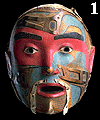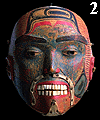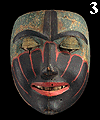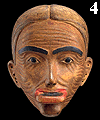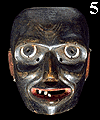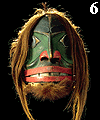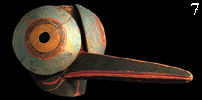|
|
-
Secret society mask with face painting and copper inlay; it was probably made in the 1850s and extensively trimmed with fur to form a goatee, fringe beard and hairline, but only the leather that once held the fur remains. Collected at Masset before 1884 by Alexander McKenzie of the Hudson's Bay Company.
CMC VII-B-1554
-
This very fine mask made in the middle of the 19th century once had a moustache and goatee made of bear fur. Collected on Haida Gwaii (probably Skidegate) in 1879 by Israel W. Powell.
CMC VII-B-3
-
Secret society mask made by Simeon Stiltla (1833-1883). Raven feather patterns are painted around the mouth. Collected at Masset before 1884 by Alexander McKenzie of the Hudson's Bay Company.CMC VII-B-1
-
Portrait mask by Simeon Stiltla of an old woman wearing a large labret. Collected at Masset before 1884 by Alexander McKenzie of the Hudson's Bay Company. CMC VII-B-7
-
This mask represents a gagiid, someone who narrowly escaped drowning but whose flesh has changed colour from long exposure in cold water. Collected on Haida Gwaii in 1879 by Israel W. Powell. CMC VII-B-109
-
An unusual dance mask of a supernatural being whose identity is now lost. The lips are edged with copper and the beard is bear fur. A wig of human hair completes the eclectic effect. Collected on Haida Gwaii in 1879 by Israel W. Powell. CMC VII-B-10
-
Secret society dance mask portraying a Mosquito; nail holes at the top indicate it once had fur or feather attachments. Purchased from the A. Aaronson collection in 1899 but probably acquired earlier at Masset by James Deans. CMC VII-B-704
Secular power in Haida society was wielded by the chiefs, who, unlike their Kwakwaka'wakw neighbours to the south, never yielded their power each winter to the heads of the secret societies. Nevertheless, by the mid-eighteenth century, the Haida began to practise much weaker forms of secret society winter dances, which they learned from captives taken in wars. They performed the dances at all winter festivities, including those to mark the raising of a totem pole or the building of a house. Secret societies and their performances began to disappear with the arrival of the missionaries in the mid-1870s.
Among the Haida, masks were used mostly by members of the secret societies. Secret society dances frequently used both masks and puppets to represent wild spirits of the woods, which the Haida called gagiid. The Haida also employed masks in potlatch performances to illustrate the spirit beings encountered by their ancestors.
|

